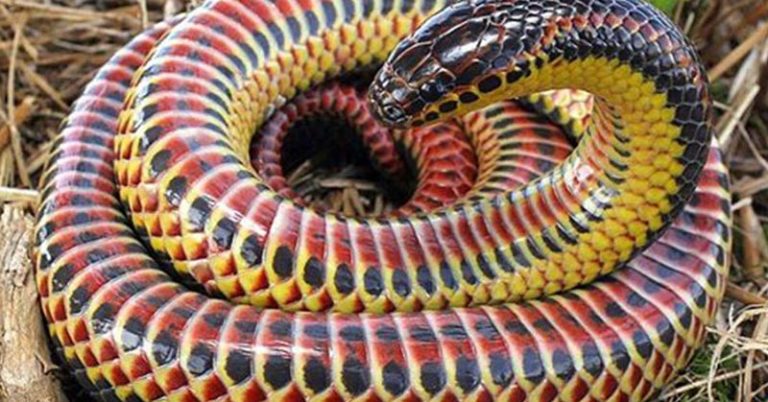One hiker in Florida, Tracey Cauthen, discovered a rare rainbow-colored snake, a rare species that experts haven’t seen in that area for over 50 years.
Cauthen spotted the beautiful four-foot-long snake while hiking through the Ocala National Forest, which is 47 miles north of Orlando. The Florida Museum of National History confirmed this sighting was the first one recorded in Marion County since 1969.
Fortunately, this snake is completely harmless and nonvenomous. Its average adult size is around 3 feet 6 inches, although the longest has been recorded to be 5 feet 6 inches by the Florida Museum of Natural History. They are usually found near bodies of water, hiding amongst the vegetation. [1]
“Rainbow snakes are highly-aquatic, spending most of their life hidden amongst aquatic vegetation; seldom seen, even by herpetologists, due to their cryptic habits,” said the Institute on Fox 8 News. “Burrowing near creeks, lakes, marshes, and tidal mudflats, rainbow snakes specialize in eating eels, earning the nickname ‘eel moccasin’.” [2]
According to Reptile Magazine, besides eels, the rainbow snake feeds on tadpoles, frogs, and other amphibians. It’s a strong swimmer and good at burrowing as well. [3]
How to Tell if a Snake is Venomous?
First off, it’s important to note that there is are very few ‘poisonous’ snakes, not because they aren’t dangerous, but because the word poisonous is a misnomer in this case. Poisonous indicates a substance that is toxic when ingested (i.e. if you ate the snake you’d become ill or even die). Venomous, on the other hand, is when an animal injects toxins into the body of their prey via biting or stinging. Since we generally don’t make a habit of eating snakes, the venomous variety are the one’s hikers, gardeners, and the like, need to watch out for.
You may have seen or heard of many ways to spot a venomous snake, such as checking for round or slit pupils or the shape of their snout. However, there are so many exceptions, that these rules become impractical. In fact, many of these ‘rules’ are just plain wrong.
The best way to tell if a snake is venomous is to ask an expert. Do research before hiking in new locations and find out which snakes were spotted in the area and how to respond when they appear [4][5].
What Should You Do If You’re Bitten by a Venomous Snake?
“The first thing to do is get away from the snake — don’t try to capture it, that’s just going to provide the potential for more people to get hurt,” said Dr. Nicholas Kman, professor of emergency medicine at The Ohio State University Wexner Medical Center.
“And then, they should immediately seek medical treatment, because these symptoms can progress rapidly. We watch for redness, swelling, blistering, warmth and then signs of nausea, vomiting, muscle pain, and low blood pressure. If we start to see those, we administer the antivenom.”
Almost three million people worldwide are poisoned after being bitten by a venomous snake. Fortunately, only a fraction of these incidents proved to be fatal, but that doesn’t downplay the dangerous outcomes of these bites. Within a few hours, the victim could experience organ failure, uncontrollable bleeding, severe tissue damage, and paralysis that can restrict breathing. These symptoms vary from snake to snake. For example, rattlesnake bites can induce redness and pain minutes after the bite while copperheads’ effects usually take longer to show.
Here are some tips on how to respond to a snake bite:
- Seek immediate medical care
- In the meantime, keep the wound clean and elevate the affected limb. If possible, monitor the victim’s heart rate.
- Remain as calm as still as possible to slow the spreading of the venom.
How NOT to respond to a snake bite:
Despite what all the movies say, don’t try to suck out the venom or cut it out. Suction is useless, and cutting can cause further injury.
“I’ve seen cases of hand bites where someone cut their hand and cut through a tendon,” Kman said. “Venom is going to be absorbed into the body right away, so all you’re going to do is cause more trauma. You shouldn’t ice the bite, steroids shouldn’t be used, there’s a lot of things people do that aren’t going to help a snakebite, and are probably going to make the patient worse.”
Also, don’t apply a tourniquet if the snake is native to North America, since many of these snakes’ venom can cause excessive bleeding and tissues and muscle necrosis, and any form of restricting circulation can worsen the harm.
“Putting a tourniquet on can actually increase local injury, and people can lose fingers or toes or need skin grafts,” said Dr. Dan Brooks, medical director of the Banner Poison and Drug Information Center in Phoenix, Arizona.
Overall, different kinds of snakes require different kinds of treatments and it’s wise to research native snakes before exploring any natural area. In the meantime, more research is being put into anti-venoms and accessible snake venom treatment. [5]
Sources
- Kyle Spinner. Rare snake discovered in Ocala National Forest. CBS 12 February 20, 2020
- Rare rainbow snake spotted in Florida forest for first time in 50 years. CNN Wire. Fox 8. https://myfox8.com/news/rare-rainbow-snake-spotted-in-florida-forest-for-first-time-in-50-years/ February 22, 2020
- John Virata. Rainbow Snake Seen In Florida’s Ocala National Forest For First Time Since 1969 Reptile Magazine. http://www.reptilesmagazine.com/Rainbow-Snake-Seen-In-Floridas-Ocala-National-Forest-For-First-Time-since-1969/ February 20, 2020
- Ada McVean B.Sc. Fake Snake News: How Not to Identify a Poisonous Snake. McGill.https://www.mcgill.ca/oss/article/did-you-know-general-science/fake-snake-news-how-not-identify-poisonous-snake July 10, 2018
- Mindy Weisberger. What Should You If You’re Bitten by a Venemous Snake? Live Science. https://www.livescience.com/65614-what-if-bitten-by-snake.html June 2, 2019

